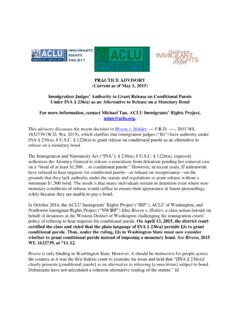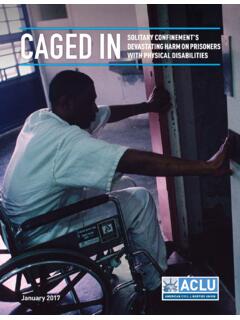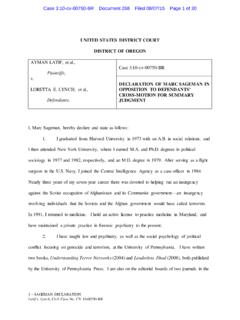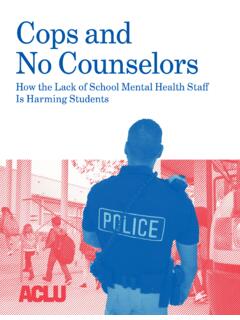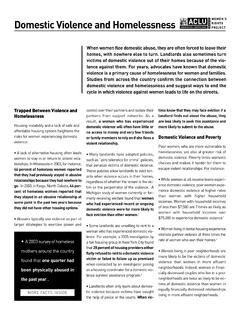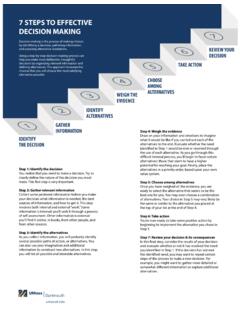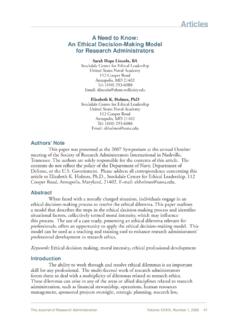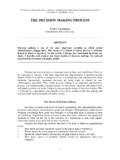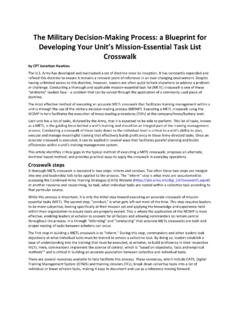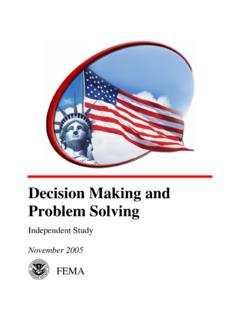Transcription of What is supported decision-making? What does supported ...
1 supported decision - making : Frequently Asked Questions What is supported decision - making ? supported decision making (SDM) is a tool that allows people with disabilities to retain their decision - making capacity by choosing supporters to help them make choices. A person using SDM selects trusted advisors, such as friends, family members, or professionals, to serve as supporters. The supporters agree to help the person with a disability understand, consider, and communicate decisions, giving the person with a disability the tools to make her own, informed, decisions. What does supported decision - making actually look like? SDM will look different for everyone. It means finding tools and supports to help a person with a disability understand, make, and communicate her own choices. Examples of these tools might be: plain language materials or information in visual or audio form extra time to discuss choices creating lists of pros and cons role-playing activities to help the person understand choices bringing a supporter into important appointments to take notes and help the person remember and discuss her options opening a joint bank account to manage financial decisions together Once supported decision - making is formally recognized (as it is already in Texas), then a person with a disability will be able to sign a formal document with his supporters in which they all agree to undertake SDM.
2 This document would help doctors, bankers, lawyers, and other third parties to feel confident in accepting the decision of the person with a disability without fearing lawsuits or malpractice claims. How is SDM different from a durable power of attorney? A durable power of attorney identifies the person who will be the substitute decision -maker if a person becomes incapacitated. It is a complex document that may require a high level of understanding to execute validly. An SDM agreement identifies the people who will support the person in making her own decisions. It goes into effect right now. It is not a contract, but an authorization, and is much easier to understand and execute validly. How is SDM different from person-centered planning? Person-centered planning is an approach to future planning and Individual Program Plan (IPP). development that focuses on the preferences of a person with a disability and his or her family. Person- centered planning is a great example of a type of supported decision - making .
3 For many people, the person-centered planning process will be one of the tools they use to support their decisions. 1. How is SDM different from guardianship (called conservatorship in California)? GUARDIANSHIP/CONSERVATORSHIP supported decision - making . Who makes the The guardian/conservator has the right to The person with a disability uses support, decision ? make the final decisions about the but ultimately makes the final choice ward/conservatee's life about his own life. What is the role of All changes have to go through the court. The person with a disability can change the court? the supporters they use anytime they If there is a problem with a conservator or want without a court process . guardian, or if the conservator or guardian dies, the court must approve any They can easily add supporters and get changes or appointment of new the insights of many people. guardians/conservators. The court can replace a guardian or conservator with someone else if they think it best, or grant the conservator/guardian more powers than they requested.
4 What are the Typically, only one conservator/guardian There will usually be multiple supporters. protections against makes all the decisions for one They may provide support in different abuse? conservatee/ward. areas ( , a parent may help with money, while a friend or staff member may help The court technically oversees the with social decisions); or they may work relationship but rarely does so in practice. together to provide support ( , two supporters help the person make medical decisions). Having more than one supporter provides a check against abuse or manipulation by any one supporter. A monitor can also be appointed to oversee the supporters, and is advisable when finances are included. How are the The abilities and needs of the person with The strengths and needs of a person are person's needs a disability are determined by a judge discussed by the person and her assessed? based on the person's score and supporters. diagnosis. The person's abilities are based on what The court looks at what the person can do she can do both alone and with supports.
5 By herself, without any assistance or support. The person can modify the supports she needs and the supporters who provide The court assumes that these needs will these over the course of her life, as she remain the same over the course of the continues to learn and develop decision - person's life. making skills. 2. How is SDM different from Regional Center authority to consent to medical treatment under the California Lanterman Act? (Specific to California residents). Section 4655 of the Lanterman Act allows the director of a Regional Center or their designee to consent to medical, dental, and surgical treatment for a Regional Center client under certain circumstances. This requires a determination that the person is mentally incapable of providing consent. The Regional Center designee is typically unfamiliar with the patient and must quickly learn a great deal about the patient's preferences, health, and abilities. By contrast, the supporters identified in an SDM. agreement are close and trusted friends of the person with a disability, and are more likely to be accessible and in close proximity to the person.
6 An SDM agreement would likely allow the process of medical consent to proceed more smoothly than providing consent under Section 4655. SDM also avoids the need to label the patient as mentally incapable. How is SDM different from discussions we have at home with my child with a disability? Many families, support staff, and other advocates are already having conversations and using SDM in their everyday lives. Helping a person learn decision - making skills by making her own choices with help and guidance is supported decision - making . So, if I'm already doing this, what does it matter what we call it? Even though many families and support workers are already using supported decision - making , formalizing SDM can help ensure that the choices of people with disabilities are respected. People with disabilities who do not have guardians or conservators may find that doctors, nurses, bankers, teachers, or lawyers do not believe that the person with a disability has capacity to make his own choice.
7 Sometimes hospitals will tell families that they must get a conservatorship or guardianship before a surgery or procedure can be performed. Recognition of SDM would allow a person with a disability to present his SDM agreement in a situation like this. The agreement would serve as documentation that the person is able to make his own choices, as assurance to the doctor that the person's decisions are informed and supported , and as protection against malpractice, as long as the doctor relies on the agreement in good faith. Recognition of SDM is also important to emphasize that people with disabilities have rights and autonomy. Where can I learn more about supported decision - making ? ACLU Disability Rights Program, National Resource Center for supported decision - making , Quality Trust for Individuals with Disabilities, 3.



